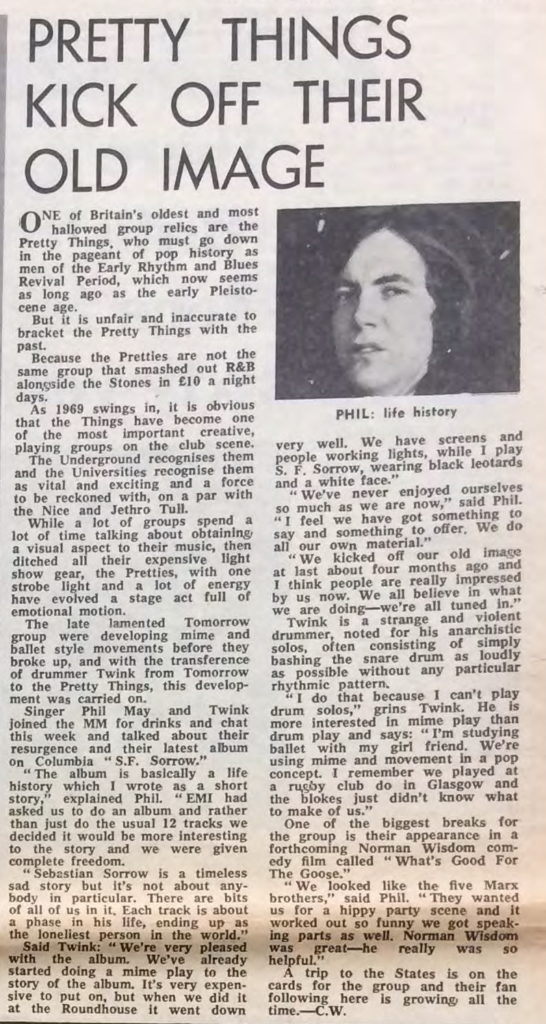Cet article de Chris Welch est paru dans le numéro de l’hebdomadaire britannique Melody Maker daté du 4 janvier 1969.
Illustré par une photo peu flatteuse de Phil May, il annonce en des termes dépourvus d’ambigüité l’évolution des Pretty Things : adieu le rhythm & blues, bonjour le psychédélisme ! May et Twink évoquent ce changement d’image et leurs espoirs pour le spectacle de mime inspiré de S. F. Sorrow. L’article mentionne également l’apparition du groupe dans le film What’s Good for the Goose et évoque une prochaine tournée américaine qui n’aura en fin de compte jamais lieu.

Transcription
One of Britain’s oldest and most hallowed group relics are the Pretty Things, who must go down in the pageant of pop history as men of the Early Rhythm and Blues Revival Period, which now seems as long ago as the early Pleistocene age.
But it is unfair and inaccurate to bracket the Pretty Things with the past.
Because the Pretty Things are not the same group that smashed out R&B alongside the Stones in £10 a night days.
As 1969 swings in, it is obvious that the Things have become one of the most important creative, playing groups on the club scene.
The Underground recognises them and the Universities recognise them as vital and exciting and a force to be reckoned with, on a par with the Nice and Jethro Tull.
While a lot of groups spend a lot of time talking about obtaining a visual aspect to their music, then ditched all their expensive light show gear, the Pretties, with one strobe light and a lot of energy have evolved a stage act full of emotional motion.
The late lamented Tomorrow group were developing mime and ballet style movements before they broke up, and with the transference of drummer Twink from Tomorrow to the Pretty Things, this development was carried on.
Singer Phil May and Twink joined the MM for drinks and chat this week and talked about their resurgence and their latest album on Columbia “S.F. Sorrow.”
“The album is basically a life history which I wrote as a short story,” explained Phil. “EMI had asked us to do an album and rather than just do the usual 12 tracks we decided it would be more interesting to the story and we were given complete freedom.
“Sebastian Sorrow is a timeless sad story but it’s not about anybody in particular. There are bits of all of us in it. Each track is about a phase in his life, ending up as the loneliest person in the world.”
Said Twink: “We’re very pleased with the album. We’ve already started doing a mime play to the story of the album. It’s very expensive to put on, but when we did it at the Roundhouse it went down very well. We have screens and people working lights, while I play S. F. Sorrow, wearing black leotards and a white face.”
“We’ve never enjoyed ourselves so much as we are now,” said Phil. “I feel we have got something to say and something to offer. We do all our own material.”
“We kicked off our old image at last about four months ago and I think people are really impressed by us now. We all believe in what we are doing—we’re all tuned in.”
Twink is a strange and violent drummer, noted for his anarchistic solos, often consisting of simply bashing the snare drum as loudly as possible without any particular rhythmic pattern.
“I do that because I can’t play drum solos,” grins Twink. He is more interested in mime play than drum play and says: “I’m studying ballet with my girl friend. We’re using mime and movement in a pop concept. I remember we played at a rugby club do in Glasgow and the blokes just didn’t know what to make of us.”
One of the biggest breaks for the group is their appearance in a forthcoming Norman Wisdom comedy film called “What’s Good For The Goose.”
“We looked like the five Marx brothers,” said Phil. “They wanted us for a hippy party scene and it worked out so funny we got speaking parts as well. Norman Wisdom was great—he really was so helpful.”
A trip to the States is on the cards for the group and their fan following here is growing all the time.
Source : WorldRadioHistory.com (PDF).